Irrigation Scheduling and Weed Management: A Sustainable Approach for Managing Broomrape and Other Weeds in Tomato Crop
Abstract
1. Introduction
2. Materials and Methods
2.1. Experimental Site and Pedo-Climatic Conditions
2.1.1. Experimental Procedure
2.1.2. Weed Management Treatments
2.1.3. Irrigation Scheduling and Treatment Application
2.2. Measurements and Data Collection
2.2.1. Weed Density
2.2.2. Broomrape Intensity of Attack Plant−1 of Tomato
2.2.3. Dry Weed Biomass
2.2.4. Plant Height, Number of Fruits Plant−1 of Tomato and Fruit Yield
2.2.5. Cost/Benefit Ratio
2.2.6. Statistical Analysis
3. Results
3.1. Weed Density
3.2. Broomrape Intensity of Attack Plant−1 of Tomato
3.3. Dry Weeds Biomass
3.4. Plant Height
3.5. Number of Fruits Plant−1 of Tomato
3.6. Fruit Yield of Tomato
3.7. Cost/Benefit Ratio
4. Discussion
5. Conclusions
Author Contributions
Funding
Institutional Review Board Statement
Informed Consent Statement
Data Availability Statement
Acknowledgments
Conflicts of Interest
References
- Bergougnoux, V. The history of tomato: From domestication to biopharming. Biotechnol. Adv. 2014, 32, 170–189. [Google Scholar] [CrossRef] [PubMed]
- Lifschitz, E.; Eviatar, T.; Rozman, A.; Shalit, A.; Goldshmidt, A.; Amsellem, Z.; Alvarez, J.P.; Eshed, Y. The tomato FT ortholog triggers systemic signals that regulate growth and flowering and substitute for diverse environmental stimuli. Proc. Natl. Acad. Sci. USA 2006, 103, 6398–6403. [Google Scholar] [CrossRef] [PubMed]
- Jones, J.B., Jr. Tomato Plant Culture: In the Field, Greenhouse, and Home Garden; CRC Press: Boca Raton, FL, USA, 2007. [Google Scholar] [CrossRef]
- Food and Agriculture Organization of the United Nations. Crops and Livestock Products. 2022. Available online: https://www.fao.org/faostat/en/#data/QCL (accessed on 12 May 2022).
- Ijaz, A.; Khan, I.; Zareen, S.; Khan, M.I.; Khan, R.; Haroon, M. Yield and Yield Attributes of Tomato (Lycopersicon esculentum Mill) Cultivars Influenced by Weed Management Techniques. Pak. J. Weed Sci. Res. 2017, 23, 431–438. [Google Scholar]
- Chaudhari, S.; Jennings, K.; Monks, D.; Jordan, D.; Gunter, C.; McGowen, S.; Louws, F. Critical Period for Weed Control in Grafted and Nongrafted Fresh Market Tomato. Weed Sci. 2016, 64, 523–530. [Google Scholar] [CrossRef]
- Piwowarczyk, R.; Schneider, A.C.; Góralski, G.; Kwolek, D.; Denysenko-Bennett, M.; Burda, A.; Ruraż, K.; Joachimiak, A.J.; Pedraja, Ó.S. Phylogeny and historical biogeography analysis support Caucasian and Mediterranean centres of origin of key holoparasitic Orobancheae (Orobanchaceae) lineages. PhytoKeys 2021, 174, 165–194. [Google Scholar] [CrossRef]
- Adewale Osipitan, O.; Hanson, B.D.; Goldwasser, Y.; Fatino, M.; Mesgaran, M.B. The potential threat of branched broomrape for California processing tomato: A review. Calif. Agric. 2021, 75, 64–73. [Google Scholar] [CrossRef]
- Fawad, M.; Khan, M.A. Impact of Irrigation Timing and Weed Management Practices on Chlorophyll Content and Morphological Traits of Tomato (Solanum lycopersicum Mill.). Gesunde Pflanz. 2022, 74, 317–332. [Google Scholar] [CrossRef]
- Aly, R. Conventional and biotechnological approaches for control of parasitic weeds. Vitr. Cell. Dev. Biol. -Plant 2007, 43, 304–317. [Google Scholar] [CrossRef]
- Ahmad, M.; Shah, S.A.; Ali, S. Allocative Efficiency of Tomato Growers in District Mardan, Khyber Pakhtunkhwa Province of Pakistan. Sarhad J. Agric. 2019, 35, 675–685. [Google Scholar] [CrossRef]
- Holm, L.; Doll, J.; Holm, E.; Pancho, J.V.; Herberger, J.P. World Weeds: Natural Histories and Distribution; John Wiley & Sons: Hoboken, NJ, USA, 1997. [Google Scholar]
- Abdel-Kader, M.; El-Mougy, N. Applicable control measure against Orobanche ramosa in tomato plants. Australas. Plant Pathol. 2007, 36, 160–164. [Google Scholar] [CrossRef]
- Chastagner, G.; Ogawa, J. A fungicide-wax treatment to suppress Botrytis cinerea and protect fresh-market tomatoes [Postharvest decay]. Phytopathology 1979, 69, 59–63. [Google Scholar] [CrossRef]
- Shende, N.V.M.R.R. Cost benefit analysis and marketing of tomato. Am. Int. J. Res. Form. App. Nat. Sci. 2015, 11, 46–54. [Google Scholar]
- Steel, R.G.; Torrie, J.H. Principles and Procedures of Statistics: A Biometrical Approach; McGraw-Hill New York: New York, NY, USA, 1980; Volume 2. [Google Scholar]
- Gholamhoseini, M.; AghaAlikhani, M.; Modarres Sanavy, S.A.M.; Mirlatifi, S.M.; Zakikhani, H. Response of corn and redroot pigweed to nitrogen fertilizer in different irrigation regimes. Agron. J. 2013, 105, 1107–1118. [Google Scholar] [CrossRef]
- Kishore, G.; Babu, B.M.; Kandpal, K.; Satishkumar, U.; Ayyangowdar, M. Effect of plastic mulching and irrigation levels on weed growth and quality parameters of tomato crop (Solanum lycopersicum). Pharma Innov. J. 2018, 7, 685–688. [Google Scholar]
- Ngadze, E.; Mashingaidze, A.B.; Sibiya, J. Weed density and biomass are reduced and plant growth and seed yield increased in common bean after solarisation with clear and black plastic. S. Afr. J. Plant Soil 2018, 35, 223–230. [Google Scholar] [CrossRef]
- Qin, X.; Li, Y.; Han, Y.; Hu, Y.; Li, Y.; Wen, X.; Liao, Y.; Siddique, K.H. Ridge-furrow mulching with black plastic film improves maize yield more than white plastic film in dry areas with adequate accumulated temperature. Agric. For. Meteorol. 2018, 262, 206–214. [Google Scholar] [CrossRef]
- Mauromicale, G.; Monaco, A.L.; Longo, A.M.; Restuccia, A. Soil solarization, a nonchemical method to control branched broomrape (Orobanche ramosa) and improve the yield of greenhouse tomato. Weed Sci. 2005, 53, 877–883. [Google Scholar] [CrossRef]
- Mauro, R.P.; Monaco, A.L.; Lombardo, S.; Restuccia, A.; Mauromicale, G. Eradication of Orobanche/Phelipanche spp. seedbank by soil solarization and organic supplementation. Sci. Hortic. 2015, 193, 62–68. [Google Scholar] [CrossRef]
- Barker, A.V.; Bhowmik, P.C. Weed control with crop residues in vegetable cropping systems. J. Crop Prod. 2001, 4, 163–183. [Google Scholar] [CrossRef]
- Rajablariani, H.R.; Hassankhan, F.; Rafezi, R. Effect of colored plastic mulches on yield of tomato and weed biomass. Int. J. Environ. Sci. Dev. 2012, 3, 590. [Google Scholar] [CrossRef][Green Version]
- Oke, A.M.; Osilaechuu, A.P.; Aremu, T.E.; Ojediran, J.O. Effect of drip irrigation regime on plant height and stem girth of tomato (Lycopersicon esculentum Mill). IOP Conf. Ser. Earth Environ. Sci. 2020, 445, 012016. [Google Scholar] [CrossRef]
- Díaz-Pérez, J.C.; Batal, K.D. Colored plastic film mulches affect tomato growth and yield via changes in root-zone temperature. J. Am. Soc. Hortic. Sci. 2002, 127, 127–135. [Google Scholar] [CrossRef]
- Aruna Olasekan, A. Legume mulch materials and poultry manure affect soil properties, and growth and fruit yield of tomato. Agric. Conspec. Sci. 2018, 83, 161–167. Available online: https://hrcak.srce.hr/203014 (accessed on 14 May 2022).
- Pinder, R.; Rana, R.; Maan, D.; Kumar, K. Impact of Different Mulching Materials on the Growth and Yield of tomato (Solanum lycopersicum) in Dehradun region of Uttarakhand. Int. J. Environ. Agric. Biotechnol. 2016, 1, 238579. [Google Scholar] [CrossRef]
- Helyes, L.; Varga, G. Irrigation demand of tomato according to the results of three decades. Acta Hortic. 1994, 376, 323–328. [Google Scholar] [CrossRef]
- Ayankojo, I.T.; Morgan, K.T. Optimizing tomato growth and productivity using nitrogen and irrigation application timing. Agronomy 2021, 11, 1968. [Google Scholar] [CrossRef]
- Jia, H.; Wang, Z.; Zhang, J.; Li, W.; Ren, Z.; Jia, Z.; Wang, Q. Effects of biodegradable mulch on soil water and heat conditions, yield and quality of processing tomatoes by drip irrigation. J. Arid Land 2020, 12, 819–836. [Google Scholar] [CrossRef]
- Shukla, Y.B.P.; Thakur, K.S. Mulch Cover Management for Improving Weed Control in Tomato (Solanum lycopersicum L.) Production. J. Exper. Agri. Intern. 2020, 42, 37–43. [Google Scholar]
- Habimana, S.; Nduwumuremyi, A.; Chinama, R.J. Management of Orobanche in field crops: A review. J. Soil Sci. Plant Nutr. 2014, 14, 43–62. [Google Scholar] [CrossRef]
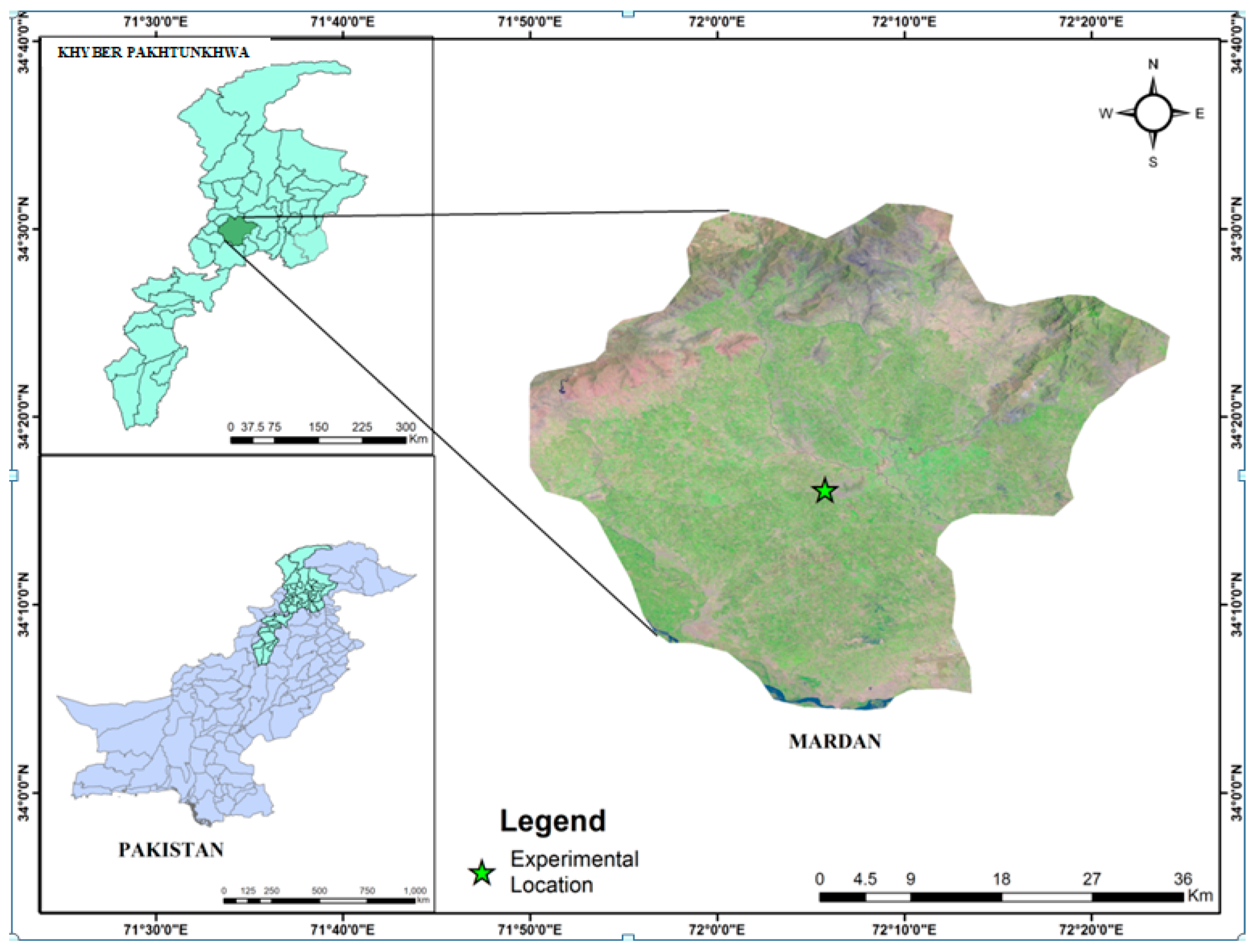

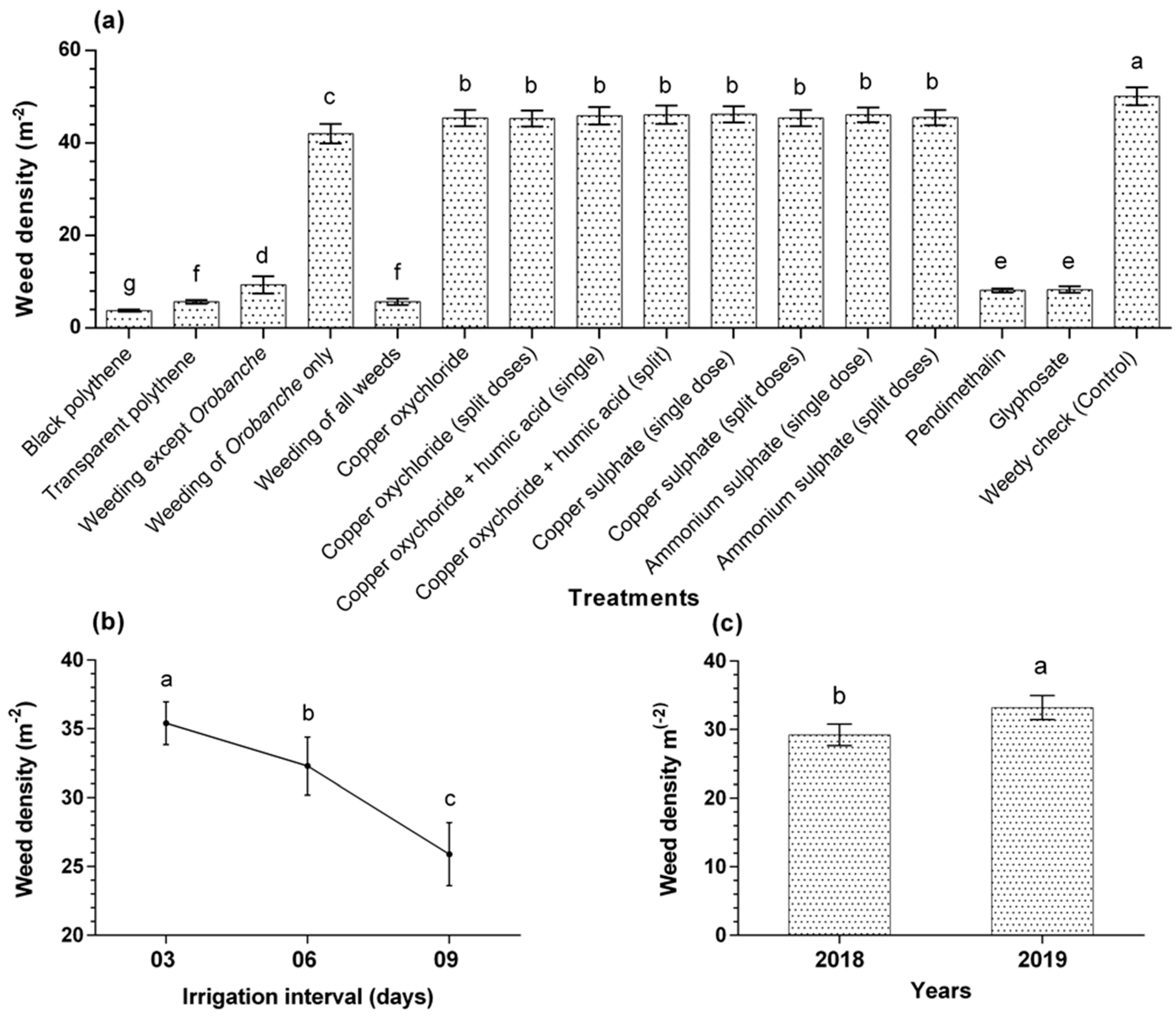
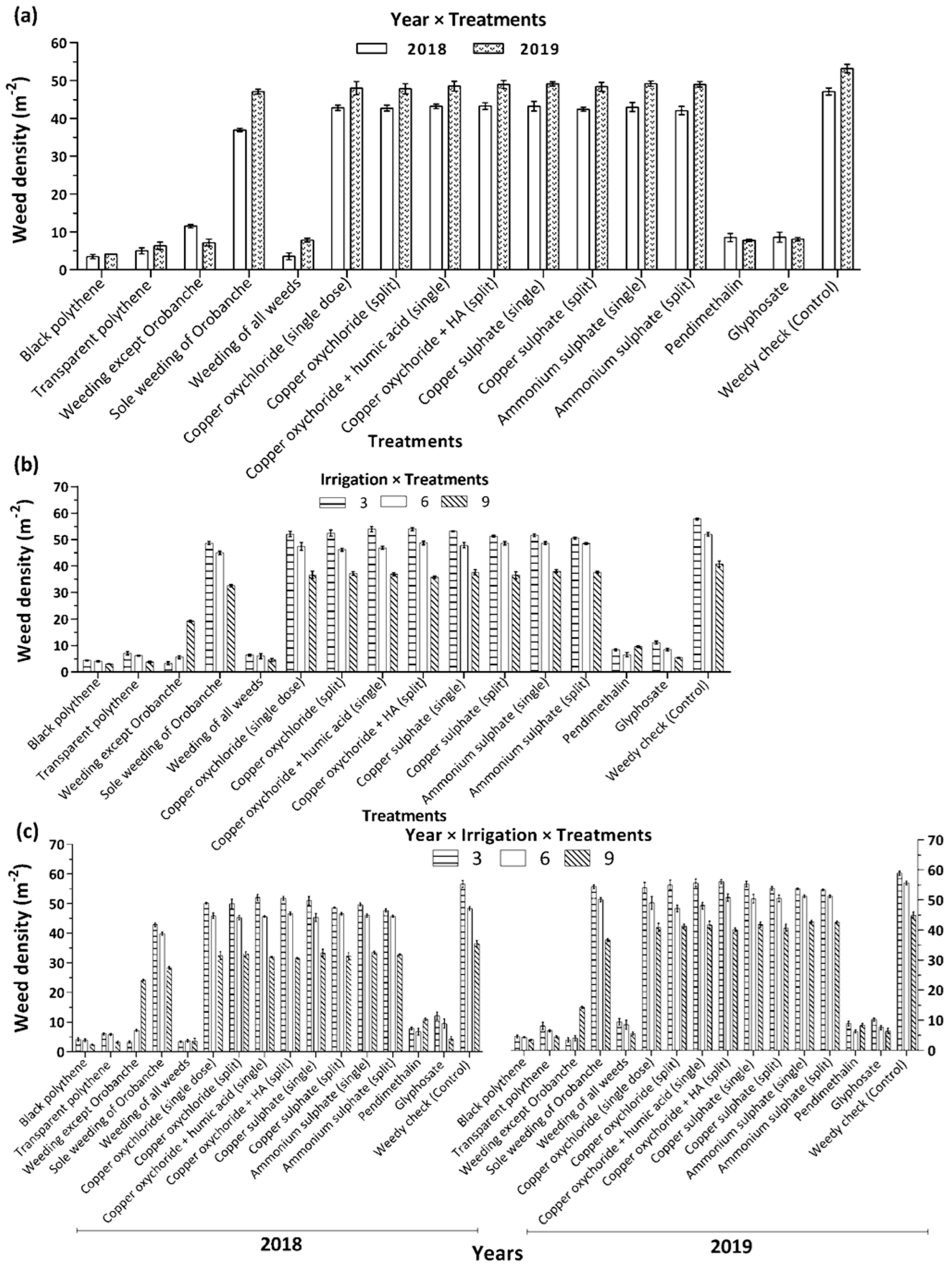
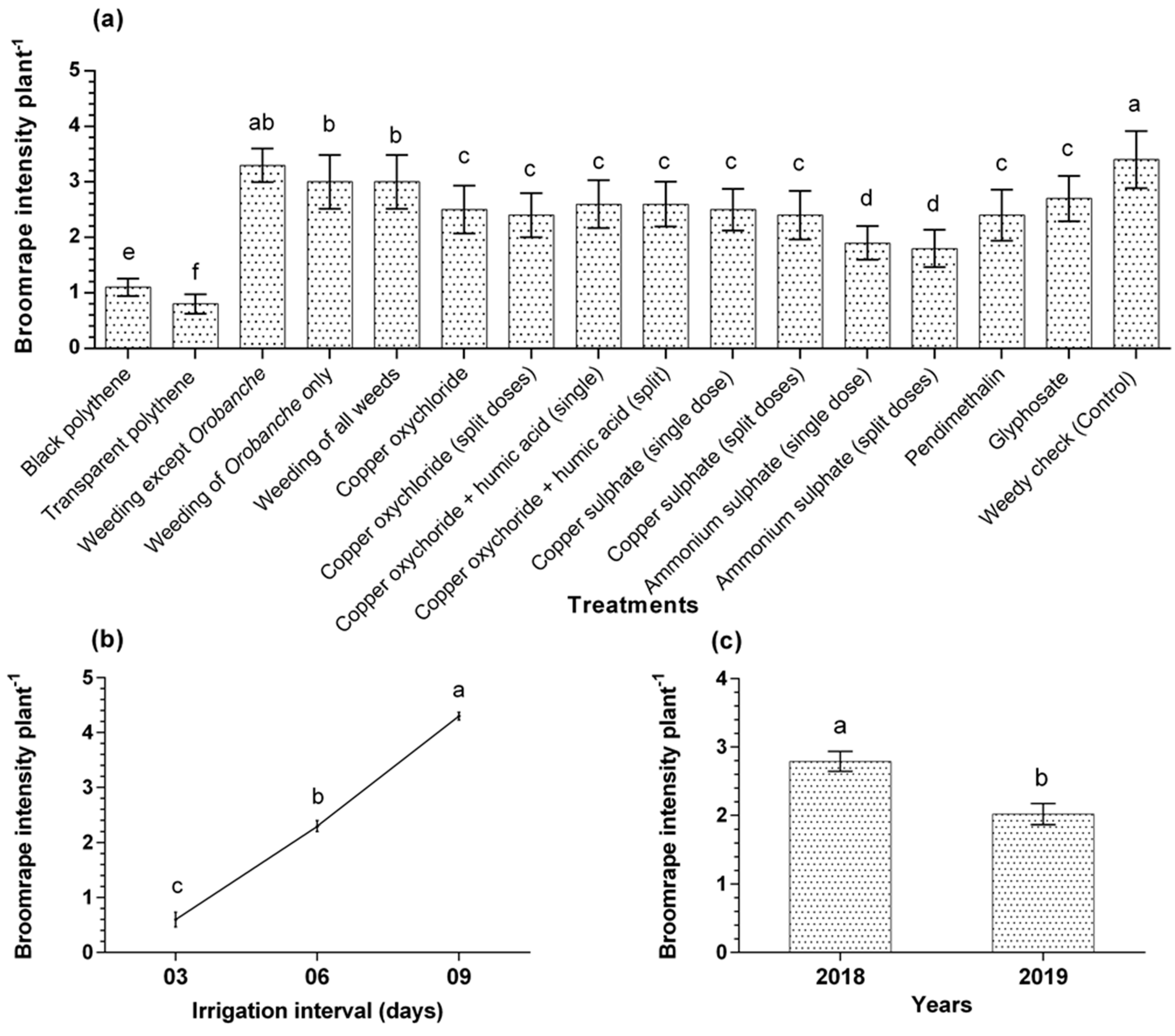
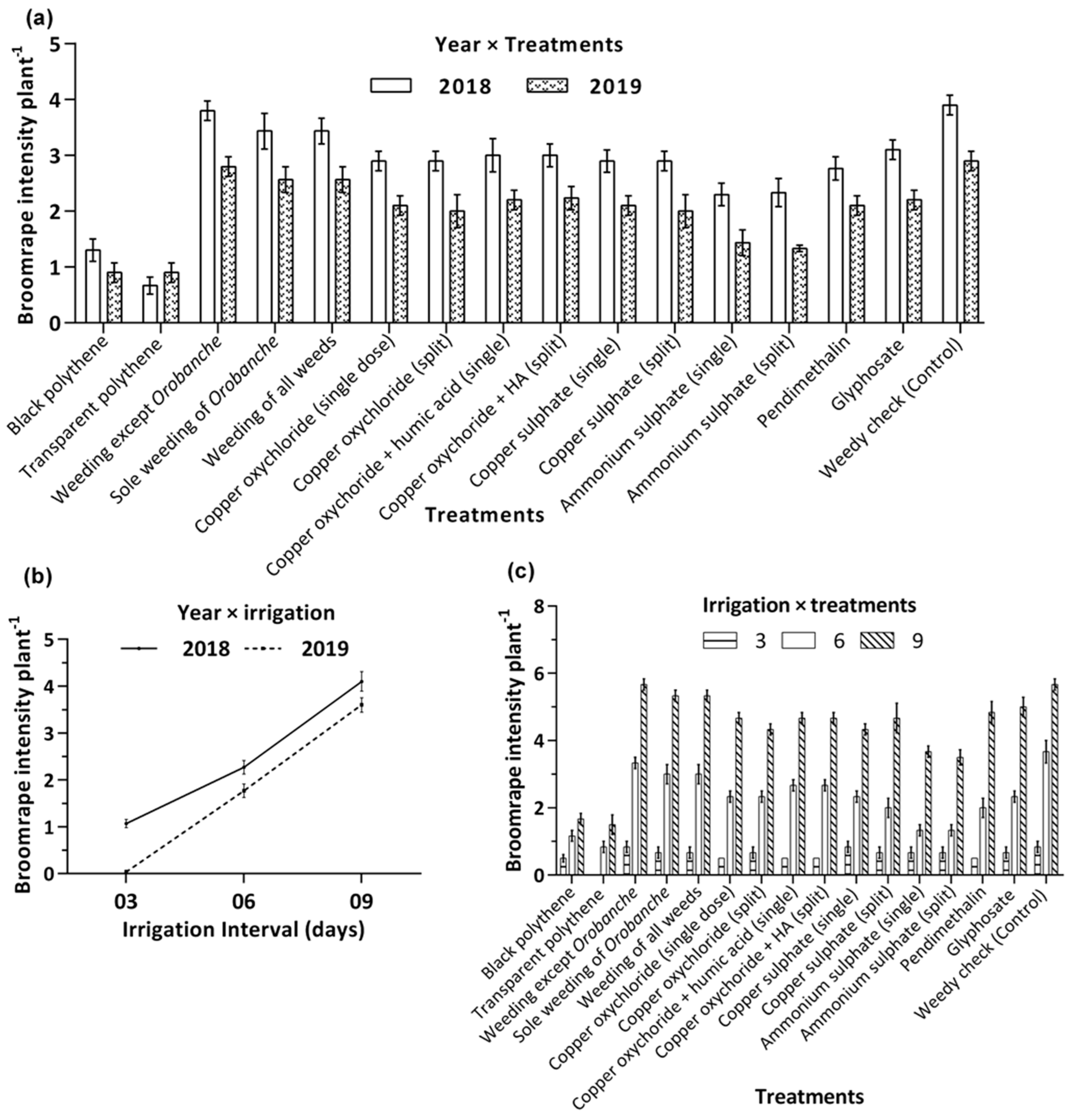

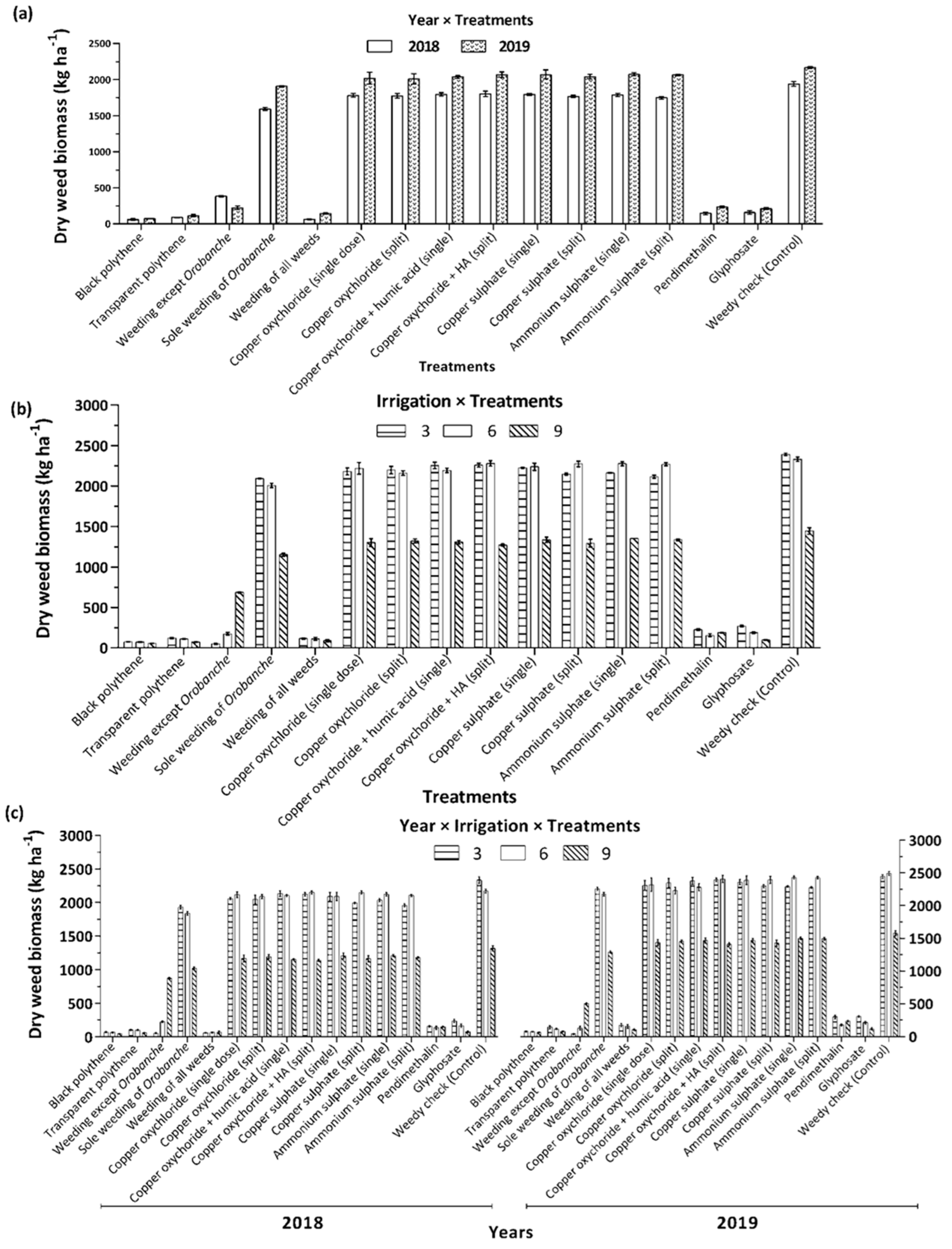
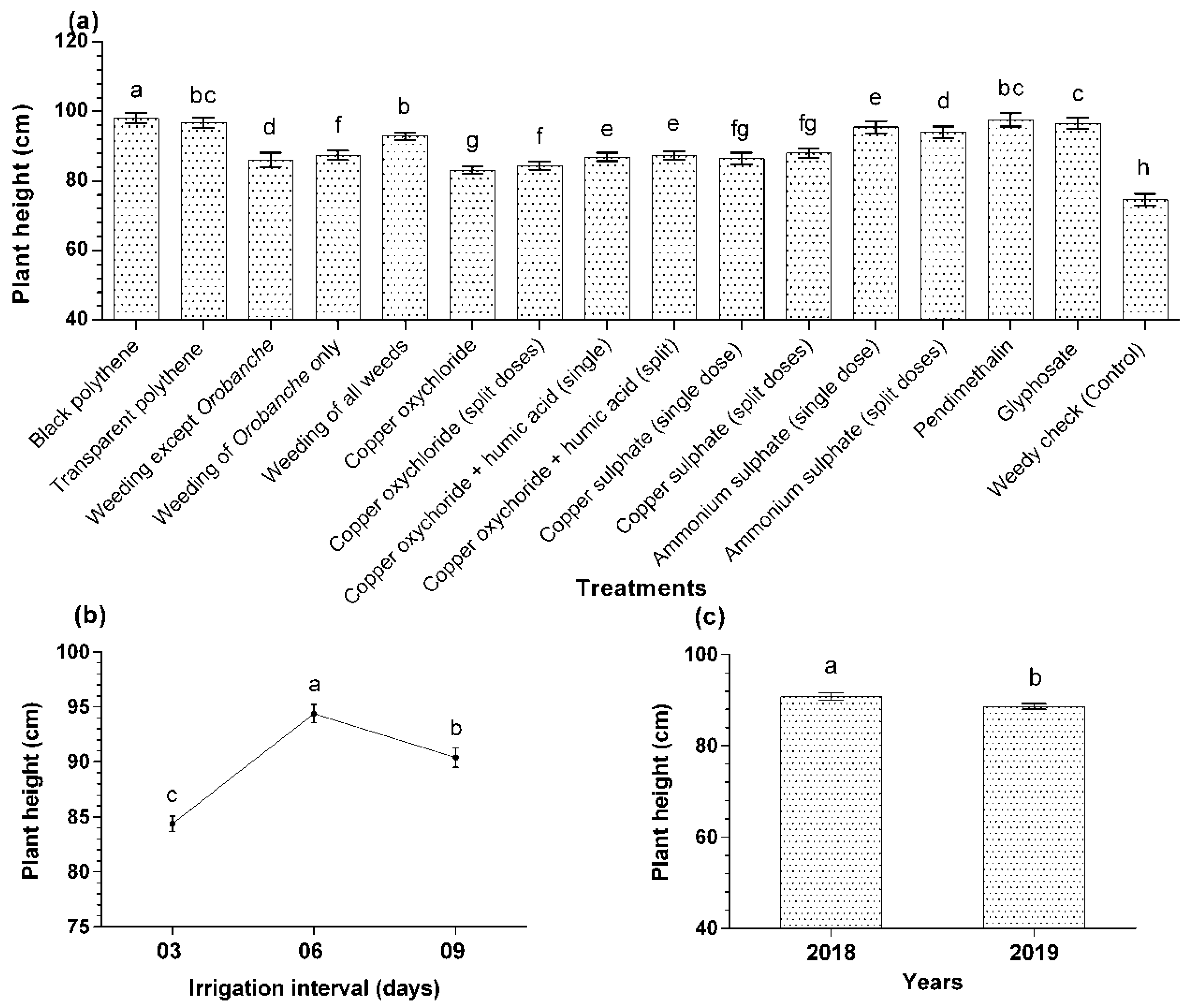
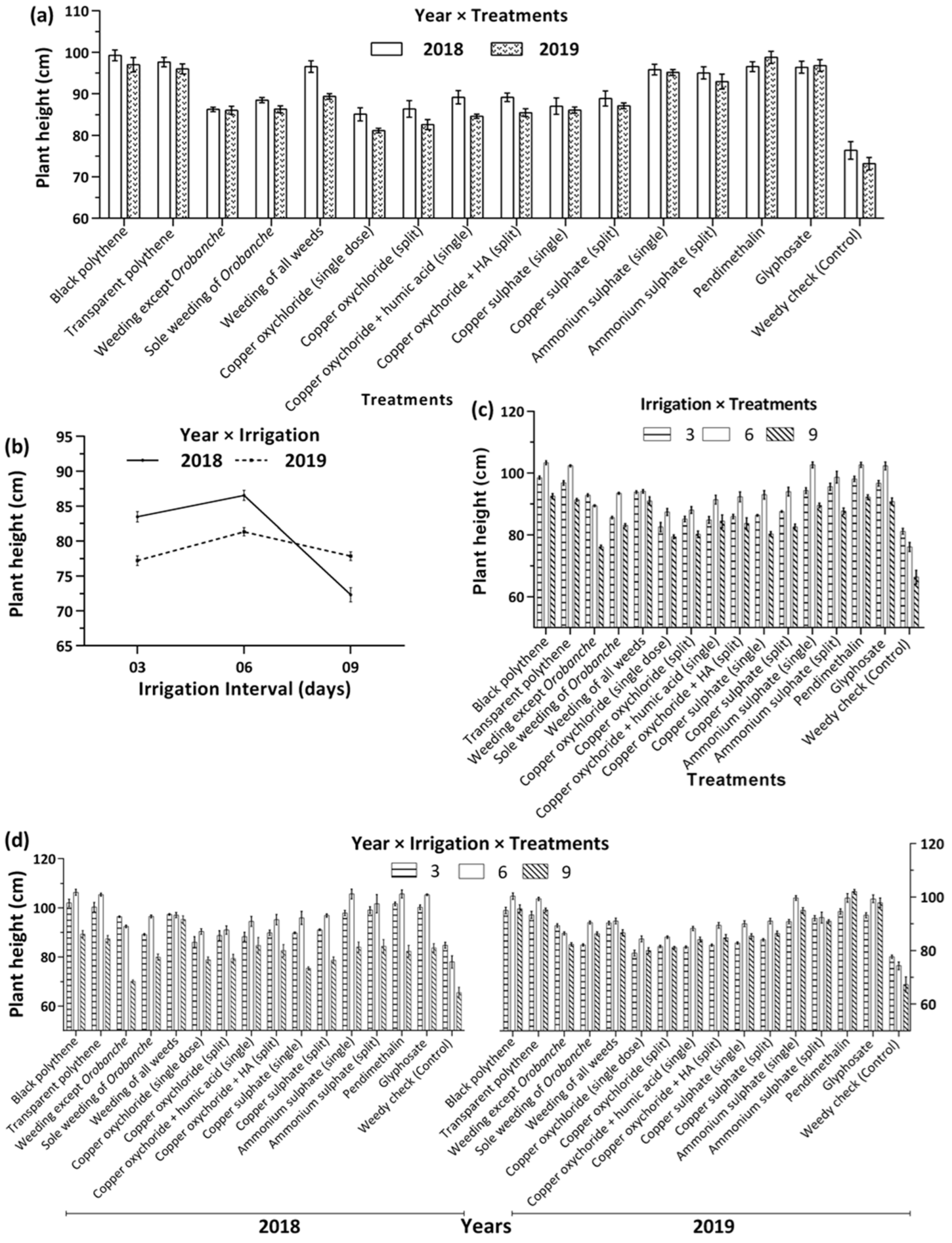
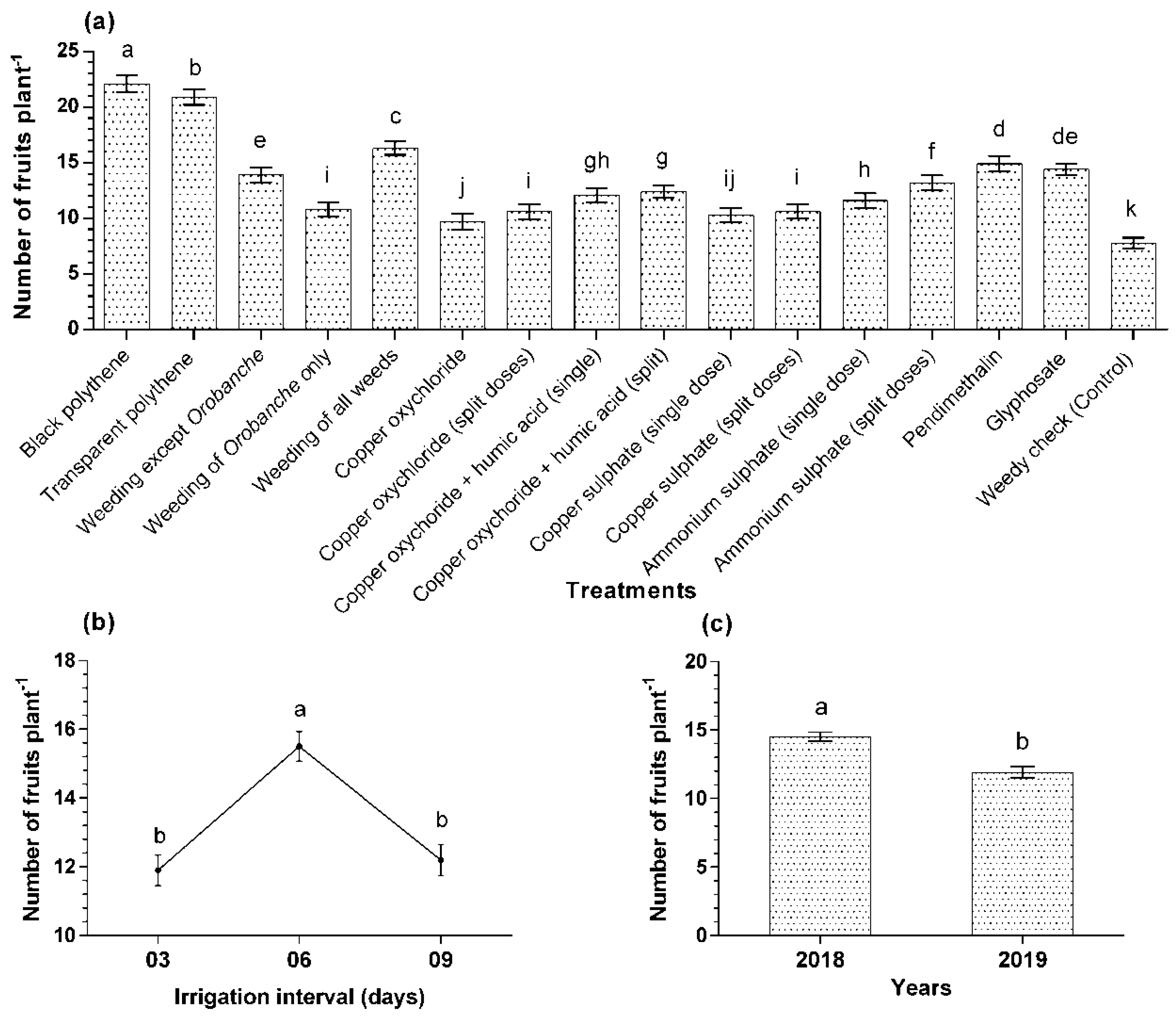
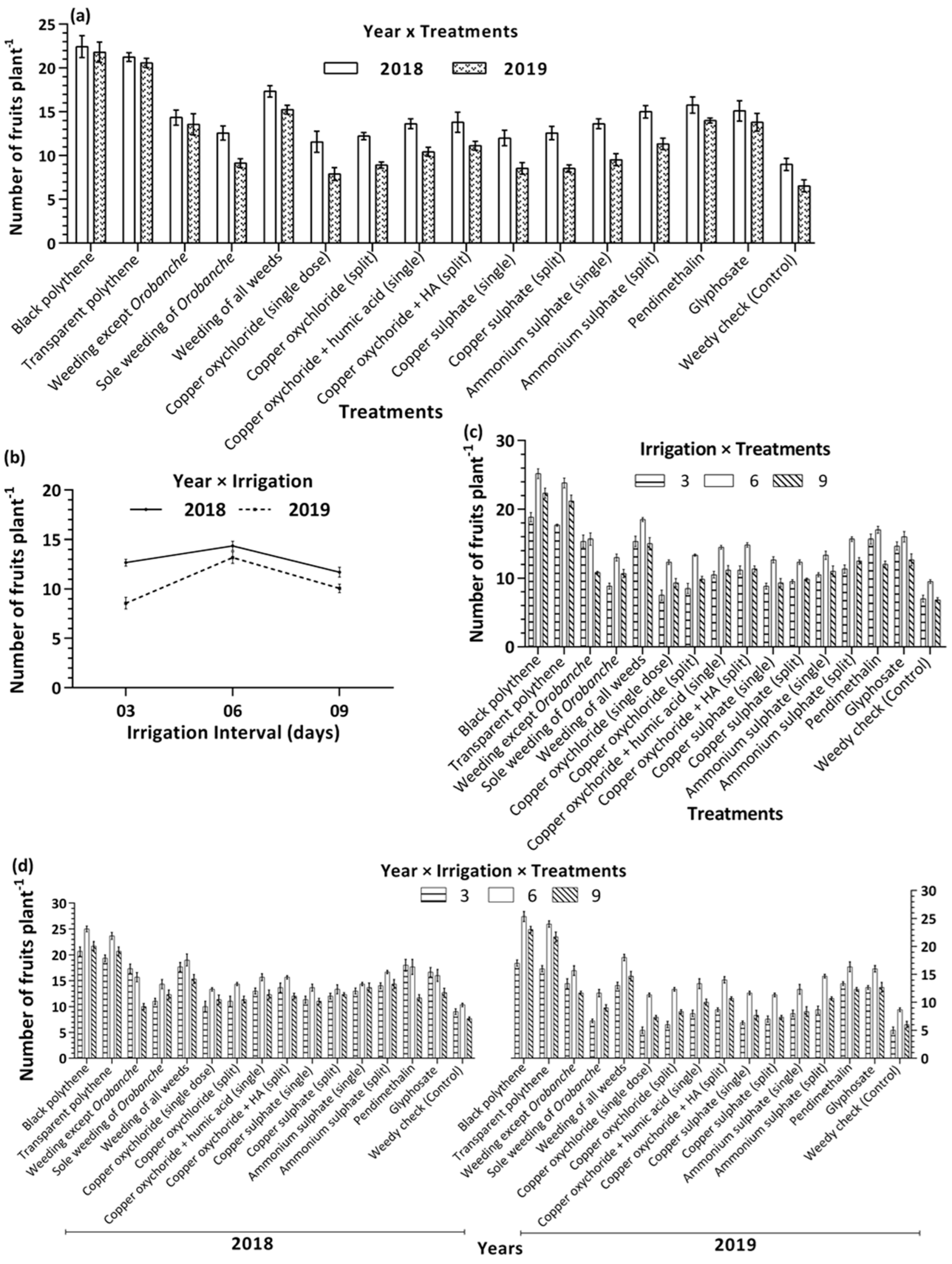
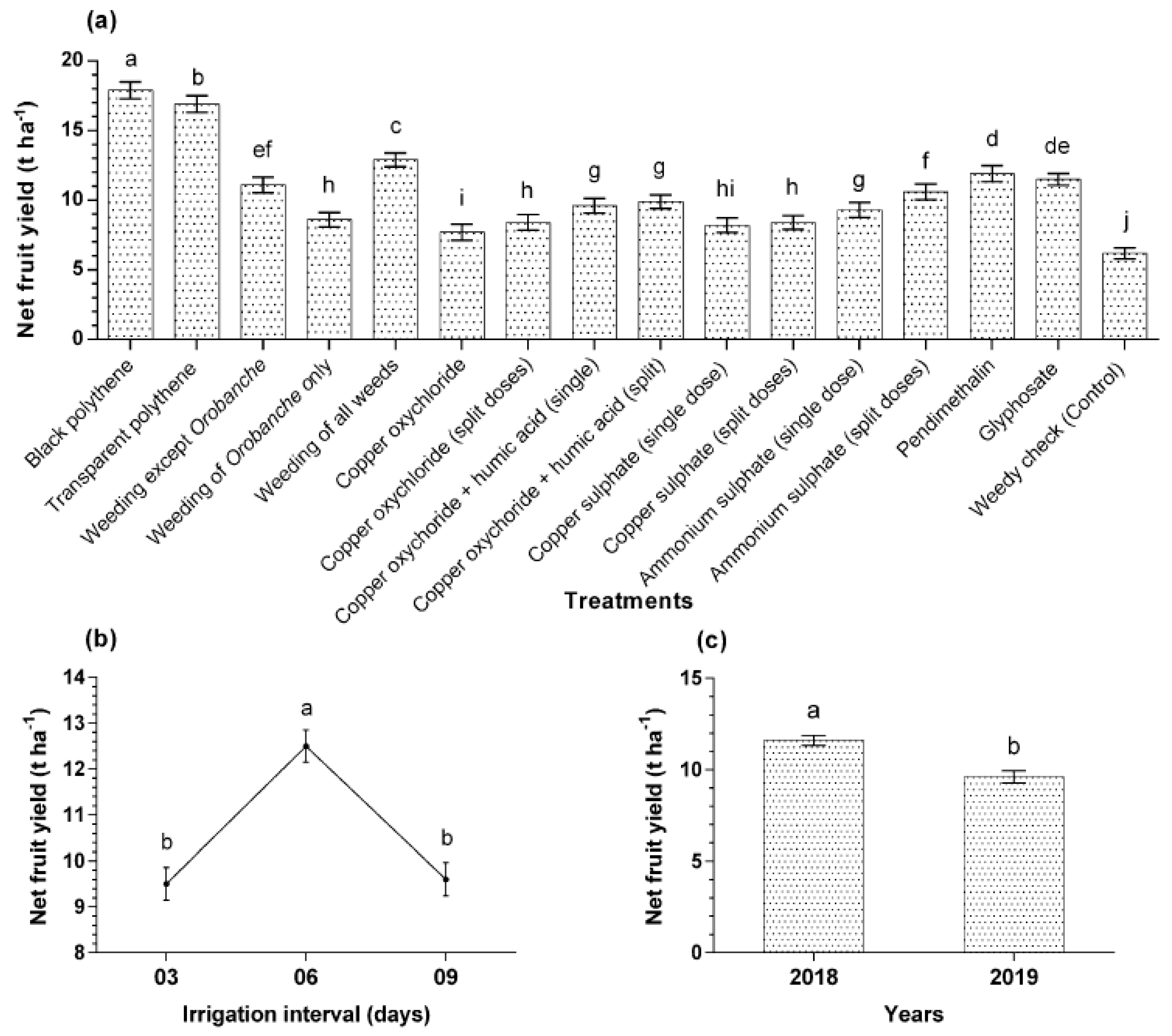
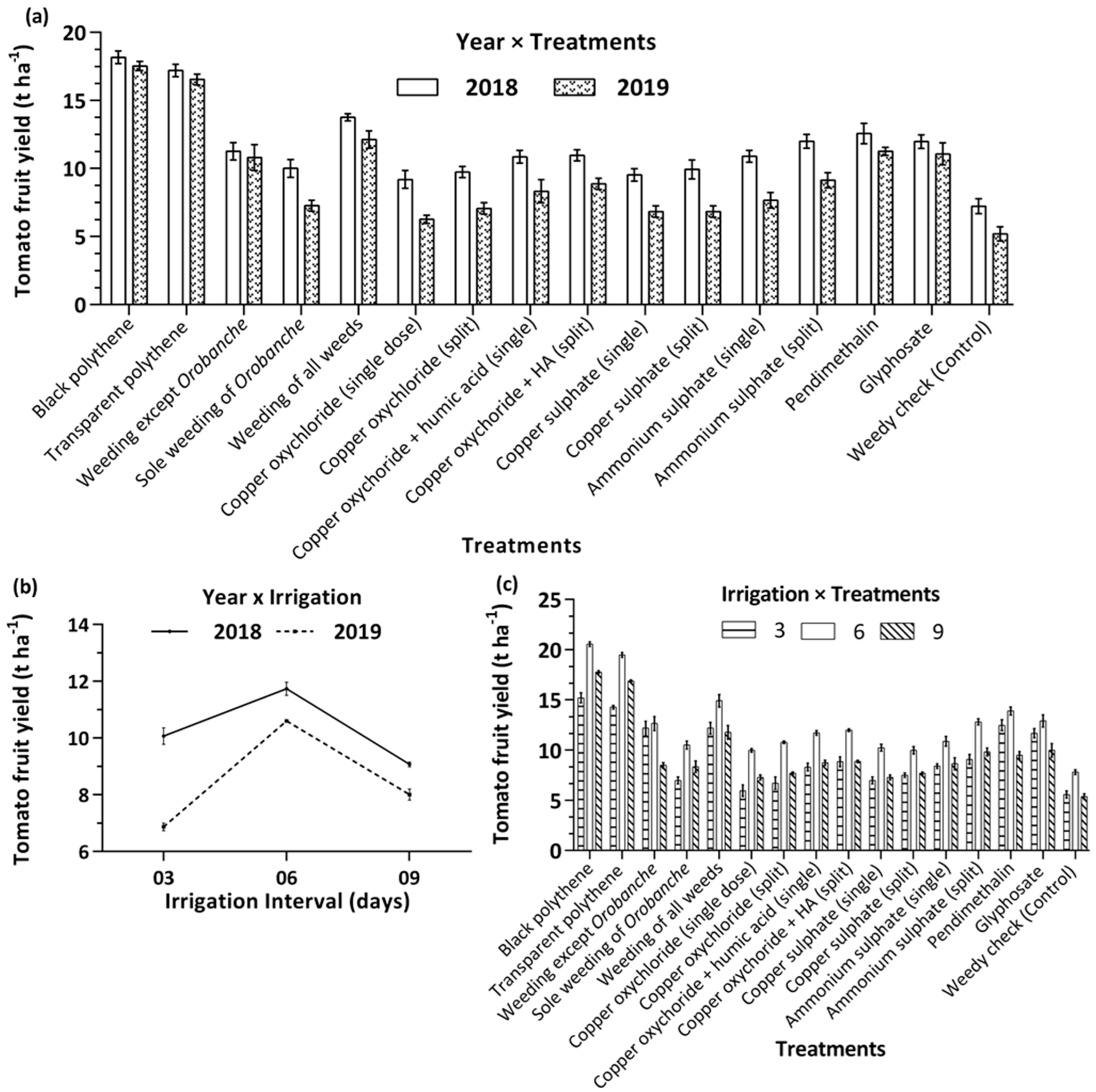
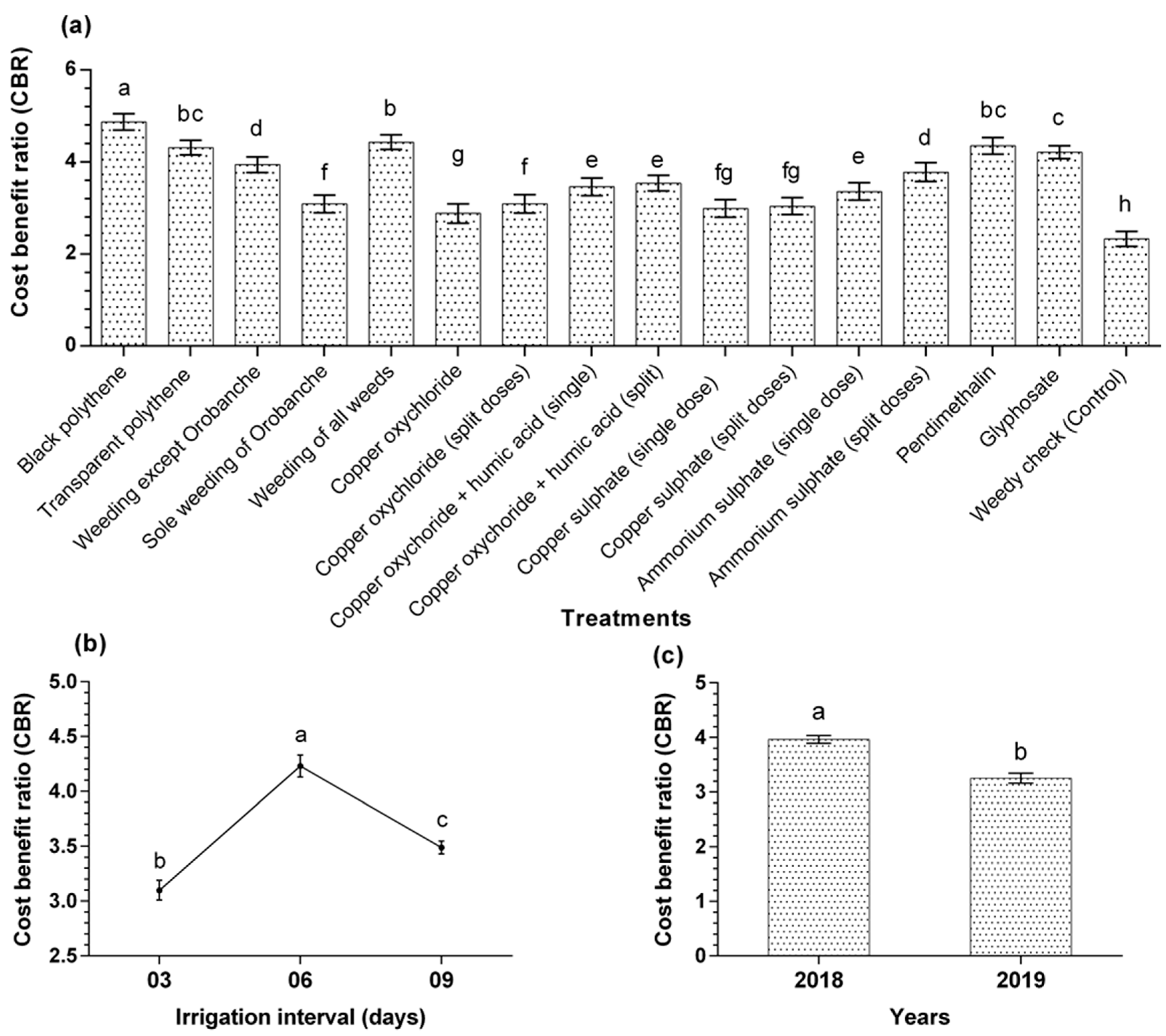
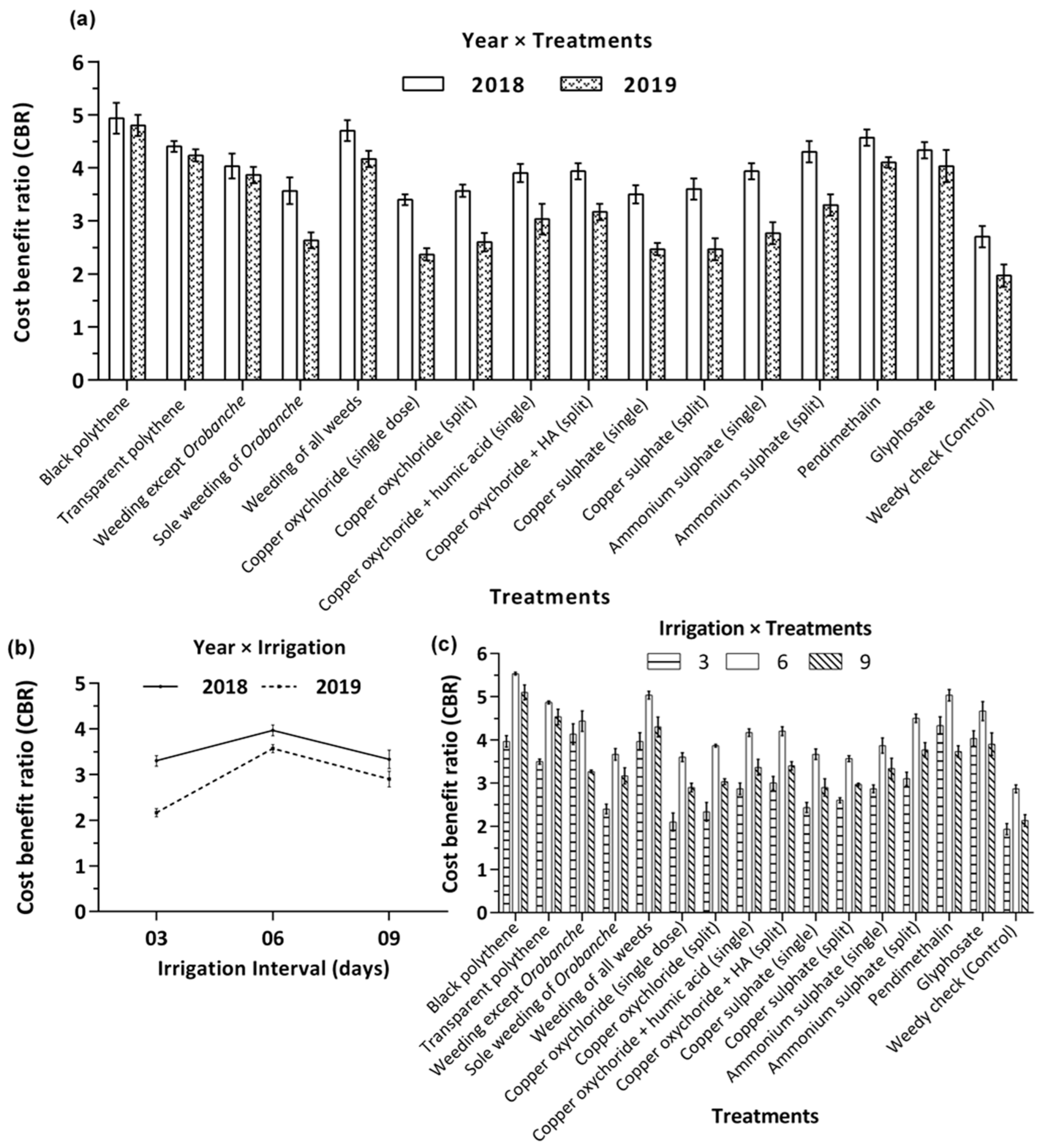
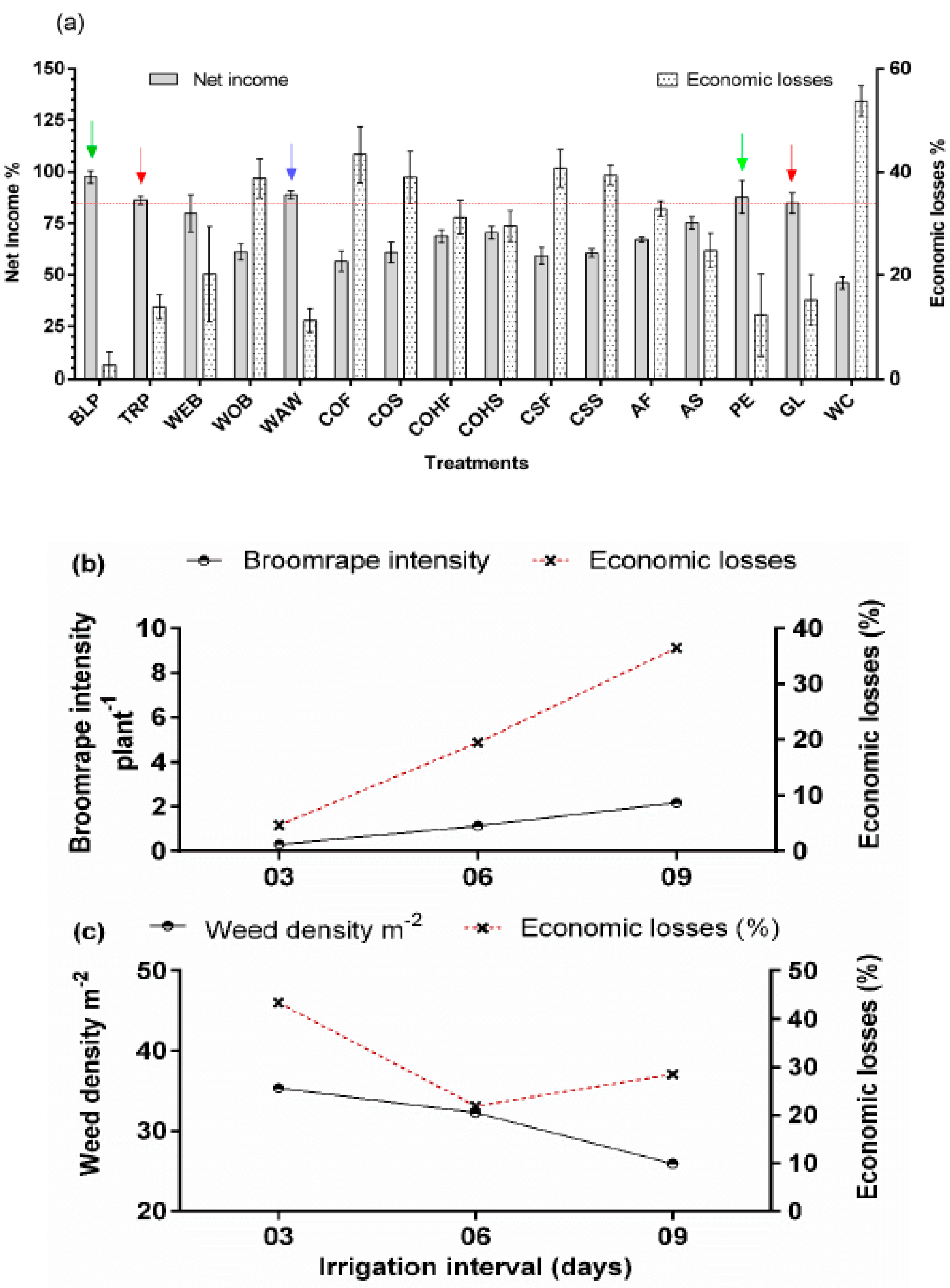
Publisher’s Note: MDPI stays neutral with regard to jurisdictional claims in published maps and institutional affiliations. |
© 2022 by the authors. Licensee MDPI, Basel, Switzerland. This article is an open access article distributed under the terms and conditions of the Creative Commons Attribution (CC BY) license (https://creativecommons.org/licenses/by/4.0/).
Share and Cite
Fawad, M.; Khan, M.A.; Wahid, F.; Khan, H.; Gul, B.; Khattak, A.M.; Jamal, A.; Mastinu, A. Irrigation Scheduling and Weed Management: A Sustainable Approach for Managing Broomrape and Other Weeds in Tomato Crop. Horticulturae 2022, 8, 676. https://doi.org/10.3390/horticulturae8080676
Fawad M, Khan MA, Wahid F, Khan H, Gul B, Khattak AM, Jamal A, Mastinu A. Irrigation Scheduling and Weed Management: A Sustainable Approach for Managing Broomrape and Other Weeds in Tomato Crop. Horticulturae. 2022; 8(8):676. https://doi.org/10.3390/horticulturae8080676
Chicago/Turabian StyleFawad, Muhammad, Muhammad Azim Khan, Fazli Wahid, Haroon Khan, Bakhtiar Gul, Abdul Mateen Khattak, Aftab Jamal, and Andrea Mastinu. 2022. "Irrigation Scheduling and Weed Management: A Sustainable Approach for Managing Broomrape and Other Weeds in Tomato Crop" Horticulturae 8, no. 8: 676. https://doi.org/10.3390/horticulturae8080676
APA StyleFawad, M., Khan, M. A., Wahid, F., Khan, H., Gul, B., Khattak, A. M., Jamal, A., & Mastinu, A. (2022). Irrigation Scheduling and Weed Management: A Sustainable Approach for Managing Broomrape and Other Weeds in Tomato Crop. Horticulturae, 8(8), 676. https://doi.org/10.3390/horticulturae8080676







